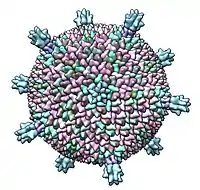Sulfolobus-Turreted-Icosahedral-Virus
Die Gattung Alphaturrivirus aus der Virusfamilie Turriviridae beinhaltet mit Stand Januar 2022 die beiden Spezies Sulfolobus-Turreted-Icosahedral-Virus 1 und 2 (STIV1/STIV2).[3] Es handelt sich um behüllte Viren mit zirkulärem, doppelsträngigem DNA-Genom. Das Wirtsspektrum umfasst Archaeen der Spezies Sulfolobus solfataricus, Familie Sulfolobaceae [en] (die zuletzt in die Gattung Saccharolobus derselben Familie verschoben wurde)[4][5][6][7] STIV wurde 2004 in einer sauren, heißen Quelle im Yellowstone-Nationalpark isoliert.[8] Die Temperatur dieser Quelle beträgt 72–92 °C bei einem pH-Wert von 2–4.[9]
| Sulfolobus-Turreted-Icosahedral-Virus | ||||||||||||||||||
|---|---|---|---|---|---|---|---|---|---|---|---|---|---|---|---|---|---|---|

Sulfolobus Turreted Icosahedral Virus 1, | ||||||||||||||||||
| Systematik | ||||||||||||||||||
| ||||||||||||||||||
| Taxonomische Merkmale | ||||||||||||||||||
| ||||||||||||||||||
| Wissenschaftlicher Name | ||||||||||||||||||
| Sulfolobus turreted icosahedral virus 1, 2 | ||||||||||||||||||
| Kurzbezeichnung | ||||||||||||||||||
| STIV1, STIV2 | ||||||||||||||||||
| Links | ||||||||||||||||||
|
Homologie
STIV besitzt Homologien zu Adenoviren, dem Bakteriophagen Pseudomonas virus PRD1 und dem Paramecium-Bursaria-Chlorella-Virus (PBCV). Dies deutet auf einen gemeinsamen Ursprung dieser Virusfamilien hin, obwohl Wirte aus drei unterschiedlichen Reichen der Lebewesen infiziert werden.[9][10]
Virion
Das Virion des STIV1 besitzt ein ikosaedrisches Kapsid mit einer Triangulationszahl von 31. An den zwölf Positionen mit fünffacher Symmetrie treten die namensgebenden, Geschützturm-artigen Peplomere mit einer Höhe von 13 nm und einem Durchmesser von 24 nm hervor.[11] Darin befindet sich ein vermutlich mit einem Deckel geschlossener Ionenkanal von etwa 3 nm Durchmesser.[11]
Das Virion verlässt die Zelle durch Knospung von der Zellmembran unter Ausbildung einer einzigartigen, pyramidalen Struktur.[11][12]
Genom
Das Genom des STIV1 besteht aus zirkulärer DNA von etwa 17663 Basenpaaren mit 36 offenen Leserastern und einem GC-Gehalt von 36 %. Daraus werden etwa 17 Proteine exprimiert.[13]
Weblinks
- Cryo-EM-Bild des STIV. Abgerufen am 22. September 2012.
Einzelnachweise
- ICTV: ICTV Taxonomy history: Sulfolobus turreted icosahedral virus 1, EC 51, Berlin, Germany, July 2019; Email ratification March 2020 (MSL #35)
- ICTV: Stand 2017
- L. J. Happonen, P. Redder, X. Peng, L. J. Reigstad, D. Prangishvili, S. J. Butcher: Familial relationships in hyperthermo- and acidophilic archaeal viruses. In: J Virol. (2010), Bd. 84(9), S. 4747–4754. PMID 20164227; PMC 2863766 (freier Volltext).
- Mark Young et al.: ICTV proposals 2013.002a-gB et al., "Create the family Turriviridae, comprising the new genus, Alphaturrivirus, and two new species" (via Webarchiv vom 26. November 2015
- Virus Taxonomy: 2014 Release, International Committee on Taxonomy of Viruses. Accessed on line Nov. 25, 2015.
- L. J. Happonen, P. Redder, X. Peng, L. J Reigstad, D. Prangishvili, S. J. Butcher: Familial Relationships in Hyperthermo- and Acidophilic Archaeal Viruses. In: Journal of Virology. 84, Nr. 9, 2010, S. 4747–4754. doi:10.1128/JVI.02156-09. PMID 20164227. PMC 2863766 (freier Volltext).
- LPSN: Saccharolobus, Sulfolobus, S. shibatae, S. solfataricus
- G. Rice, L. Tang, K. Stedman, F. Roberto, J. Spuhler, E. Gillitzer, J. E. Johnson, T. Douglas, M. Young: The structure of a thermophilic archaeal virus shows a double-stranded DNA viral capsid type that spans all domains of life. In: Proc Natl Acad Sci U S A (2004), Bd. 101(20), S. 7716–7720. PMID 15123802; PMC 419672 (freier Volltext).
- R. Khayat, L. Tang, E. T. Larson, C. M. Lawrence, M. Young, J. E. Johnson: Structure of an archaeal virus capsid protein reveals a common ancestry to eukaryotic and bacterial viruses. In: Proc Natl Acad Sci U S A (2005), Bd. 102(52), S. 18944–18949. PMID 16357204; PMC 1323162 (freier Volltext).
- C. Y. Fu, J. E. Johnson: Structure and cell biology of archaeal virus STIV. In: Curr Opin Virol. (2012), Bd. 2(2), S. 122–127. PMID 22482708; PMC 3322382 (freier Volltext).
- C. Y. Fu, K. Wang, L. Gan, J. Lanman, R. Khayat, M. J. Young, G. J. Jensen, P. C. Doerschuk, J. E. Johnson: In vivo assembly of an archaeal virus studied with whole-cell electron cryotomography. In: Structure (2010), Bd. 18(12), S. 1579–1586. PMID 21134637; PMC 3042139 (freier Volltext).
- D. Prangishvili, T. E. Quax: Exceptional virion release mechanism: one more surprise from archaeal viruses. In: Curr Opin Microbiol. (2011), Bd. 14(3), S. 315–320. PMID 21531608.
- W. S. Maaty, K. Selvig, S. Ryder, P. Tarlykov, J. K. Hilmer, J. Heinemann, J. Steffens, J. C. Snyder, A. C. Ortmann, N. Movahed, K. Spicka, L. Chetia, P. A. Grieco, E. A. Dratz, T. Douglas, M. J. Young, B. Bothner: Proteomic analysis of Sulfolobus solfataricus during Sulfolobus Turreted Icosahedral Virus infection. In: J. Proteome Res. (2012), Bd. 11(2), S. 1420–1432. PMID 22217245; PMC 3339632 (freier Volltext).